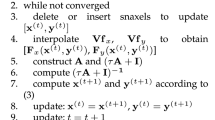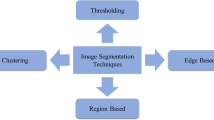Abstract
In this paper, we report an active contour algorithm that is capable of using prior shapes. The energy functional of the contour is modified so that the energy depends on the image gradient as well as the prior shape. The model provides the segmentation and the transformation that maps the segmented contour to the prior shape. The active contour is able to find boundaries that are similar in shape to the prior, even when the entire boundary is not visible in the image (i.e., when the boundary has gaps). A level set formulation of the active contour is presented. The existence of the solution to the energy minimization is also established.
We also report experimental results of the use of this contour on 2d synthetic images, ultrasound images and fMRI images. Classical active contours cannot be used in many of these images.
Similar content being viewed by others
References
Adalsteinsson, D. and Sethian, J.A. 1995. A fast level set method for propagating interfaces. J.Comput.Phys., 118(2):269–277.
Biswal, B.B. and Hyde, J.S. 1997. Contour-based registration technique to differentiate between task-activation and head motion induced signal variations in fMRI. Magn.Reson.Med., 38:470–476.
Caselles, V., Catté, F., Coll, T., and Dibos, F. 1993. Ageometric model for active contours in image processing. Numerische Mathematik, 66:1–31.
Caselles, V., Kimmel, R., and Sapiro, G. 1997. Geodesic active contours. International Journal of Computer Vision, 22(1):61–79.
Chan, T.F. and Vese, L.A. 2001. Active contours without edges. IEEE Trans.Image Processing, 10(2):266–277.
Chan, T.F. and Vese, L.A. 2001. A level set algorithm for minimizing the Mumford-Shah functional in image processing. In Proceedings 1st IEEE Workshop on Variational and Level Set Methods in Computer Vision, Vancouver, B.C., Canada, pp. 161–168.
Chen, Y., Thiruvenkadam, S., Tagare, H.D., Huang, F., Wilson, D., and Geiser, E.A. 2001a. On the Incorporation of shape priors into geometric active contours. In Proceedings 1st IEEE Work-shop on Variational and Level Set Methods in Computer Vision, Vancouver, B.C., Canada, pp. 145–152.
Chen, Y., Wilson D., and Huang, F. 2001b. Anewprocrustes methods for generating geometric models. In Proceedings of World Multiconference on Systems, Cybernetics and Informatics, Orlando, pp. 227–232.
Cohen, L.D. 1991. Pn active contour models and ballons. Image Understanding, 53:211–218.
Cootes, T., Taylor, C., Cooper, D., and Graham, J. 1995. Active shape model—their training and application. Computer Vision and Image Understanding, 61:38–59.
Cootes, T. and Taylor, C. 1999. Mixture model for representing shape variation, Image and Vision Computing, 17(8):567–574.
Cootes, T., Beeston, C., Edwards, G., and Taylor, C. 1999. Unified framework for atlas matching using active appearance models. In Int'l Conf.Inf.Proc.in Med.Imaging, Springer-Verlag, pp. 322–333.
Chopp, D. 1991. Computing minimal surface via level set curvature flows. Lawrence Berkeley Laboratory Technical Report, University of Berkeley, CA, 1991.
Cremers, D., Schnorr, C., and Weickert, J. 2001. Diffusion-snakes: Combining statistical shape knowledge and image information in a variational framework. In Proceedings of 1st IEEE Workshop on Variational and Level Set Methods in Computer Vision, Vancouver, B.C., Canada, pp. 137–144.
Dryden, I.L. and Mardia, K.V. 1988. Statistical Shape Analysis. John Wiley & Sons: New york.
Giusti, E. 1985. Minimal Surfaces and Functions of Bounded Variation. Birkhauser.
Kass, M., Witkin, A., and Terzopoulos, D. 1988. Snakes: Active contour models. Inter.Journal of Computer Vision, 1:321–331.
Kichenassamy, S., Kumar, A., Olver, P., Tannenbaum, A., and Yezzi, A.J. 1995. Gradient flows and geometric active contour models. In Proc.ICCV'95, IEEE Computer Soc. Press, Cambridge, Mass., pp. 810–815.
Kichenassamy, S., Kumar, A., Olver, P., Tannenbaum, A., and Yezzi, A.J. 1996. Conformal curvature flows: From phase transitions to active vision. Arch.Rat.Mech.and Anal., 134:275–301.
Leventon, M.E., Grimson, W.E.L., and Faugeras, O. 2000. Statistical shape influence in geodesic active contours. Proc.IEEE Conf.Comp.Vision and Patt.Recog., pp. 316–323.
Malladi, R., Sethian, J., and Vemuri, B. 1995. Shape modeling with front propagation: Alevel set approach. IEEE Trans.Pattern Anal.Machine Intell., 17:158–175.
McInerney, T. and Terzopoulous, D. 1996. Deformable models in medical image analysis: A survey. Medical Image Analysis, 1(2):91–108.
Mumford, D. and Shah, J. 1989. Optimal approximation by piecewise smooth functions and associated variational problems. Comm.Pure Appl.Math., 42:557–685.
Osher, S. and Sethian, J.A. 1988. Fronts propagating with curvature-dependent speed: Algorithms based on Hamilton-Jacobi formulation. Journal of Computational Physics, 79:12–49.
Paragios, N., Rousson, M., and Ramesh, V. 2002. Maching distance functions: Ashape-to-area variational approach for global-to-local registration. In the Proceedings of Computer Vision-ECCV2002, the 7th European Conference on Computer Vision, Copenhagen, Denmark, pp. 775–789.
Paragios, N. 2000. Geodesic active regions and level set methods: Contributions and applications in artificial vision. Ph.D. thesis, School of Computer Engineering, University of Nice/Sophia Antipolis.
Paragios, N. 2001. A variational approach for the segmentation of the left ventricle in MR cardiac images. In Proceedings 1st IEEE Workshop on Variational and Level Set methods in Com-puter Vision, 13 July 2001, Vancouver, B.C., Canada, pp. 153–160.
Paragios, N. and Deriche, R. 1999. Geodesic active regions for super-vised texture segmentation. In IEEE ICCV Cofu, Greece, pp. 926–932.
Rousson, M. and Paragios, N. 2002. Shape priors for level set rep-resentations. In the Proceedings of Computer Vision-ECCV2002, the 7th European Conference on Comuter Vision, Copenhagen, Demark, pp. 78–92.
Samson, C., Blance-Féraud, L., Aubert, G., and Zérubia, J. 2000. A level set model for image classification. Int.J.Comp.Vis., 40(3):187–197.
Satto, S. and Yezzi, A.J. 2002. Deformation: Deforming motion, shape average and the joint registration and segmentation of im-ages. In the Proceedings of Computer Vision-ECCV2002, the 7th European Conference on Computer Vision, Copenhagen, Denmark, pp. 32–47.
Small, C.G. 1996. The Statistical Theory of Shape. Springer Verlag: Berlin.
Staib, L. and Duncan, J. 1992. Boundary finding with parametrically deformable contour methods. IEEE Trans.Patt.Analysis and Mach.Intell., 14(11):1061–1075.
Sussman, M., Smereka, P., and Osher, S. 1994. A level set approach for computing solutions to incompressible two phase flow. J.Comput.Phys., 119:146–159.
Szekely, G., Kelemen, A., Brechbuhler, C., and Gerig, G. 1996. It Segmentation of 2D and 3D objects from MRI volume data using constrained elastic deformations of flexible Fourier contour and surface models. Medical Image Analysis, 1(1):199–234.
Tagare, H.D. 1997. Deformable 2-D template matching using orthog-onal curves. I.E.E.E.Trans.on Medical Imaging, 16(1):108–117.
Tsai, A., Yezzi,Jr., A., and Willsky, A.S. 2001. Curve evolution implementation of the Mumford-Shah functional for image segmentation, denoising, interpolation, and magnification. IEEE Transactions on Image Processing, 10(8):1169–1186.
Wang, Y. and Staih, L. 1998. Boundary finding with correspondence using statistical shape models. In Proc.IEEE Conf.Comp.Vision and Patt.Recog., pp. 338–345.
Yezzi, A., Kichenassamy, S., Kumar, A., Olver, P.J., and Tannenbaum, A. 1997. A geometric snake model for segmentation of medical imagery. IEEE Trans.Medical Imaging, 16:199–209.
Yuille, A., Hallinan, P.W., and Cohen, D.S. 1992. Feature extration from faces using deformable templates. Int.J.Computer Vision, 8:99–111.
Zhao, H.K., Chan, T., Merriman, B., and Osher, S. 1996. A variational level set approach to multiphase motion. J.Commput.Phys., 127:179–195.
Zhu, S.C. and Yuille, A. 1996. Region Competition: Unifying snakes, region growing, and Bayes/MDL for multiband image segmentation. IEEE PAMI, 18:884–900.
Author information
Authors and Affiliations
Rights and permissions
About this article
Cite this article
Chen, Y., Tagare, H.D., Thiruvenkadam, S. et al. Using Prior Shapes in Geometric Active Contours in a Variational Framework. International Journal of Computer Vision 50, 315–328 (2002). https://doi.org/10.1023/A:1020878408985
Issue Date:
DOI: https://doi.org/10.1023/A:1020878408985




